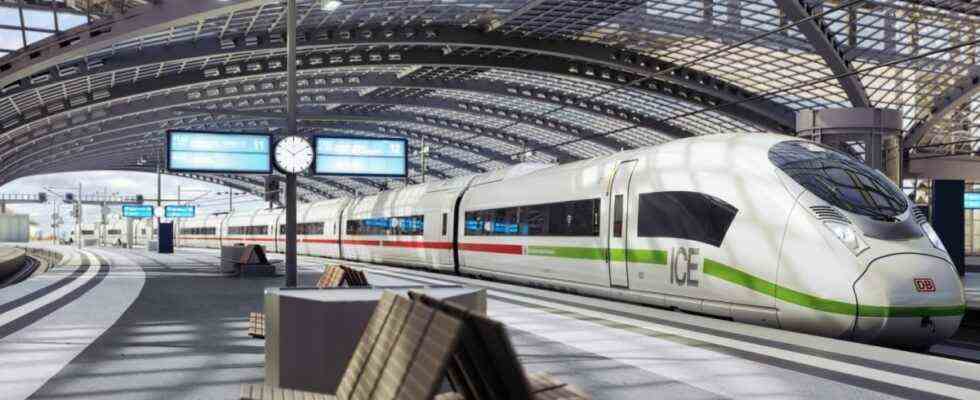There hasn’t been much to celebrate at Deutsche Bahn in the past two years. Because of the corona pandemic, many trains remained empty. The debt of the largest German state-owned company therefore climbed to new record levels. And those who got in also needed a lot of patience. The Bahnspitze registered with concern that punctuality and thus also the comfort for the passengers was recently decreasing instead of increasing. “The last two years were an exceptional situation,” admits CEO Richard Lutz.
The presentation of its new ICE flagship in Berlin on Tuesday made it clear how much Deutsche Bahn is currently hoping for positive news. Transport Minister Volker Wissing (FDP), Siemens CEO Roland Busch and Lutz rolled into a 200-meter-long ICE train with pompous music and threesomes at the Rummelsburg railway station on the outskirts of the capital. After getting off, managers and ministers praised the billion-euro project. The new ICE is fast, progressive, family and bicycle-friendly, barrier-free and a symbol for a new era of mobility.
However, anyone who enters the train will sense that the railways did not order a revolution. But things are actually changing. In the future, every seat will have a tablet holder for more convenient film watching. At the entrances to the large compartments, designers have reserved more space for luggage. In the future, customers will be able to book eight parking spaces for bicycles in each of the new ICEs.
There should also be no more arguments with neighbors about the socket in the new trains. There are two charging options between the seats instead of just one. The children’s compartments are larger, in the family compartments there is space to park prams. More doors should guarantee that boarding and alighting works faster. A lift built into the train at certain doors should make it easier for wheelchair users to get on and off.
Passengers will be able to travel on the new trains for the first time from the end of the year. The first of the 30 ICEs 3 Neo that have already been ordered will then run on the express route between North Rhine-Westphalia and Munich. On Tuesday, Deutsche Bahn announced another major order for Siemens. Deutsche Bahn wants to order another 43 trains for 1.5 billion euros from the technology group. The last of the 73 trains should be delivered by 2029. Overall, the express train fleet would grow to a total of around 450 trains by the end of the decade, the railway said.
According to Siemens CEO Busch, the billion-euro project will secure thousands of jobs
The biggest change that the new train offers customers is not visible, but it deserves extra praise from the Federal Minister of Transport. “Everything will be different,” announced Wissing. Because traveling by train and making phone calls – that should work at the same time in the future, at least in the new ICE series when traveling through Germany. This is made possible by the installation of new panes, which let cell phone radiation through differently than in the previous model. However, Wissing also concedes that dead spots along the routes could remain for the time being. The new technology will not be able to save every conversation.
The train reaches speeds of 320 kilometers per hour and is therefore significantly faster than the actually newer ICE 4, which only reaches 265 kilometers per hour. However, he needs suitable routes, such as between Cologne and Frankfurt. It is also planned to expand the east-west connection between Berlin and North Rhine-Westphalia in such a way that trains can travel there at 300 kilometers per hour and reduce the journey time. The growing fleet of high-speed ICEs could also mean that the railways will be able to reduce their journey times on express lines in the future. Lutz indicated that the railways are not already exhausting all possibilities on every route.
In order for the new train to be able to extend its speed, however, the infrastructure must be upgraded. There is a need for expansion, especially on the east-west corridor, said Lutz. The CEO referred to the planned expansion of the high-speed routes between Hanover and Bielefeld and Hanover and Berlin.
Deutsche Bahn expects that after the peak of this corona wave in spring, significantly more passengers will be traveling by train again. Whenever the pandemic allows, people would travel, Lutz said. He assumes that the number of passengers will increase significantly again. According to plans by the federal government, the railway is to double its passenger numbers by the end of the decade. The group needs significantly more trains for this. The 73 trains of the new ICE model give the railway a total of 32,000 additional seats.
The trains are built in the Siemens factory in Krefeld. Deliveries come from Nuremberg and Austria, among others. According to Siemens CEO Roland Busch, the billion-euro project will secure thousands of jobs in Germany. “At Siemens there are around 1,500 colleagues. Additional jobs come from around 230 suppliers, mostly from Germany.”
A whole new generation of ICE trains is to follow in a few years. The ICE 5 is already being developed. It is expected to be in use by the end of this decade or early next decade. Among other things, the new model should be more digital and enable level access without steps.

